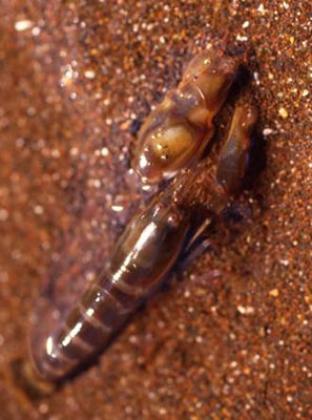Published in the Ocean Watch column, Honolulu Star-Advertiser © Susan Scott
December 20, 2010
 While describing snapping shrimp to a friend last week, I couldn’t tell her how much of a shrimp’s snapping is about diet and how much is defense. Sometimes I hear a riot of underwater crackling and wonder: What are all those shrimp doing down there? Feasting or fighting?
While describing snapping shrimp to a friend last week, I couldn’t tell her how much of a shrimp’s snapping is about diet and how much is defense. Sometimes I hear a riot of underwater crackling and wonder: What are all those shrimp doing down there? Feasting or fighting?
Looking into it, I found two new (to me) studies on these shrimp that left me as impressed with them as the day I learned they existed.
That day was years ago while I was a student at the University of Hawaii. Craig and I were still new to Hawaii, and one of his colleagues generously let us sail his boat, moored in the Ala Wai Boat Harbor. Below deck, we heard loud snaps, crackles and pops like Rice Krispies going off in milk. Craig thought the noise might have something to do with the fiberglass hull, but we ruled that out when we also heard the sound while snorkeling.
Then one day in an invertebrate zoology laboratory, I touched a pencil tip to the large, gaping claw of a 1-inch-long shrimp lying in a dish of sea water. The resulting POP! cleared up the mystery of the Rice Krispies. The racket we were hearing came from snapping shrimp.
Also called pistol shrimp, these 1- to 2-inch-long crustaceans live around the world in warm waters from the shoreline to about 40 feet deep, under rocks and in sponges, corals, cracks and self-dug burrows. At least 500 species exist, each having one front claw so bulky it looks like the shrimp is wearing a boxing glove. If the shrimp loses that claw, the other one grows big.
Scientists once believed that these shrimps’ big bang came from the claw’s two sides hitting each. A team of Dutch and German physicists discovered otherwise.
When the shrimp snaps its claw shut, a jet of water spurts out at a velocity up to 62 mph. Such speed causes the pressure around the water jet to drop, allowing a naturally occurring air bubble in the water to swell.
As this air bubble slows down, the water pressure around it rises back to normal and crushes the bubble. The resulting implosion makes a sound of 200 or so decibels, louder than a gunshot or jet engine at close range. The powerful collapse of the bubble also causes a shock wave, which stuns the shrimp’s prey or warns another snapper to back off.
Shock waves from imploding air bubbles in water are not news. The phenomenon is called cavitation and has long been known to cause damage to spinning ship propellers. The little pistol shrimps’ cavitation doesn’t affect propellers, but the racket the creatures make with it interferes with sonar navigation. In this case, biology trumps technology.
As if ear-splitting cavitation from a 1-inch-long shrimp isn’t extraordinary enough, the same researchers discovered a year later other hard-to-fathom properties of the snappers’ bubble. During collapse the bubble reaches at least 8,540 degrees Fahrenheit (the sun’s surface is about 10,000 degrees) and emits a flash of light.
The light lasts for 300-trillionths to 10-billionths of a second, too brief to see with the naked eye.
My photo here is of a 1-inch-long snapping shrimp I found under a rock (and returned) on Lanai’s Shipwreck Beach.
You can see and hear pistol shrimp in action in the following remarkable videos, the first from the researchers, the second from the BBC:
[embedyt] https://www.youtube.com/watch?v=ONQlTMUYCW4[/embedyt]
[embedyt] https://www.youtube.com/watch?v=XC6I8iPiHT8[/embedyt]
I never did find out whether the snappers are eating or warring when my sailboat sounds like a popcorn popper. After learning how the little shrimp make their big sound, though, I didn’t care.